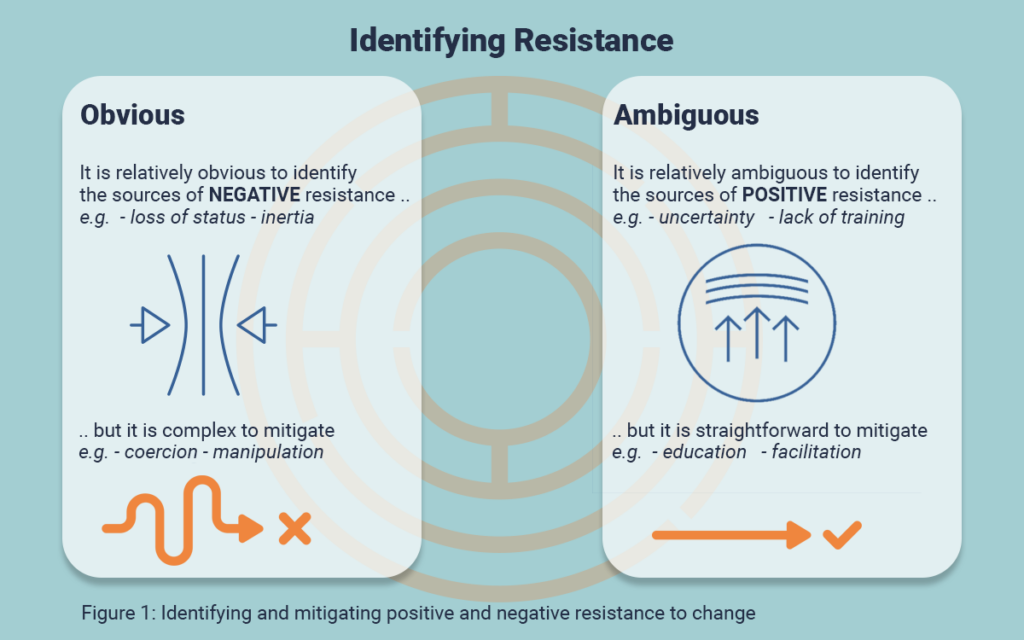It is well-known that change is inevitable for organizations, especially during such changing work environments caused by advanced technology, enforcement of new laws and regulations and the like. Change is always accompanied by resistance and there is no way to escape this phenomenon. The good news is that resistance to change sometimes could serve as an enabler to change if explored differently by change managers.
Positive vs. negative resistance
Prior to explaining how resistance to change could be facilitating the change, it is worthwhile elucidating the definition and the differences between two types of resistance: positive vs. negative as depicted in Figure 1.
Positive resistance is when change recipients are willing to adopt the change but express resistance for reasons that have beneficial implications for the organization (i.e., non-personal reasons). Negative resistance, on the other hand, is when change recipients are not willing to adopt the change because it affects their comfort, status and so on (i.e., personal reasons). Correspondingly, the reasons or the sources of resistance could be identified and then categorized into positive or negative resistance.

Figure 1: Identifying and mitigating positive and negative resistance to change
However, the attempts to identify the sources of resistance vary between positive and negative resistance. The former tends to be more ambiguous than the latter. According to Kotter, diagnosing the reasons for resistance requires careful assessment and considerations because change managers tend to have assumptions about the change recipients and why they resist.
Change managers are likely to face some challenges to figure out why some change recipients exhibit resistance that is considered positive. The change recipients themselves sometimes are not able to provide the managers with the underlying sources of their resistance (e.g. uncertainty about the future, and miscommunication with change managers). For example, change recipients of a new information system may explain that the new system is quite complicated to use but the underlying reason could be that is not the new system per se, but the new processes caused by the change.
On the contrary, resistance caused by negative sources is relatively more obvious to identify. When change recipients exhibit some resistance due to personal reasons (e.g. loss of control or prestige), change managers are able to identify the reasons. This is because negative resistance is often associated with lack of credibility and consistency of the reasons from change recipients. Therefore, the efforts put by change managers in identifying the reasons of negative resistance is likely to be less than for exploring reasons of positive resistance.
Positive and negative resistance also differ in the ways to mitigate them. For positive resistance, change recipients have the will to adopt the change and therefore by some guiding and support from change managers, the strategies to mitigate their resistance is likely to be straightforward and effective but may require some time in relation to mitigating negative resistance. For instance, for those who resist change due to lack of clarity about the future, change managers can employ education strategies to mitigate the resistance.
Negative resistance, on the other hand, is quite complex for change managers. When some change recipients do not have the will to adopt the change because they fear to lose power or comfort, change managers need to come up with innovative strategy (e.g. manipulation) to mitigate the resistance, since some convenient strategies (e.g. facilitation and persuasion) used to mitigate positive resistance are less likely to work.
Resistance as an enabler to change
It is possible for change managers to exploit the potential benefits of positive resistance in favor of the change so leaders can avoid the trap of overconfidence that the change is on the right track. Below are three methods that change mangers can employ positive resistance as an enabler to change:
- As feedback to refine the change
When change managers investigate and identify change recipients’ resistance as positive resistance, then the managers should consider the feedback from the recipients seriously and listen carefully. Such feedback could help change managers review and refine the change content and/or the process.
Change recipients who express their resistance regarding the feasibility of the change and the proposed outcomes would help change managers to re-assess and re-question the potential benefits of the change to the organization (change content). This would constitute an essential checkpoint for change managers to make sure of the alignment between the change and the intended results.
Likewise, when the exhibited resistance is concerned with the need for training the change recipients to adopt a particular technology or require some time to understand and follow a new procedure, change managers should revise the change plan to accommodate more provision of support for change recipients (change process).
- As a way for promoting the change
By expressing positive resistance from change recipients, the change is unintendedly being promoted amongst them. It increases the awareness of the change, educating the recipients about the change and its possible challenges. However, change managers should be vigilant of any rumors or inaccurate information that may spread across the recipients.
Since the exhibited resistance is positive that is not emerged from personal reasons (negative resistance), the recipients are likely to get involved in constructive conversations amongst each other to discuss the potential challenges they may encounter. This could help change managers identify and/or mitigate the resistance by having the recipients digesting and framing the concerns they have about the change.
- As an engagement opportunity
Participation and involvement of change recipients is one of the effective methods to initiate the change and deploy it. When change managers experience some positive resistance from change recipients, it constitutes an opportunity to involve the recipients in shaping the content and/or the process of change, especially for the parts that touch their roles and responsibilities.
Therefore, change managers could exploit the positive resistance expressed from the recipients and involve them in activities and discussions that matter to the recipients so the change managers can gain the trust form the recipients about making a positive impact to the organization and its stakeholders. When encountering resistance, change managers should identify the resistance to classify it whether it is positive or negative and employ the suitable strategy to mitigate it. When positive resistance is identified, change mangers should take this as an opportunity to get feedback from the recipients, promote the change to them, and engage them in forming the change so they get their buy-in to support the change.












